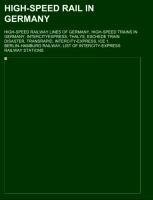
-
 Anglický jazyk
Anglický jazyk
High-speed rail in Germany
Autor: Source: Wikipedia
Source: Wikipedia. Pages: 67. Chapters: High-speed railway lines of Germany, High-speed trains in Germany, InterCityExpress, Thalys, Eschede train disaster, Transrapid, Intercity-Express, ICE 1, Berlin-Hamburg Railway, List of Intercity-Express railway stations,... Viac o knihe
Na objednávku
18.13 €
bežná cena: 20.60 €
O knihe
Source: Wikipedia. Pages: 67. Chapters: High-speed railway lines of Germany, High-speed trains in Germany, InterCityExpress, Thalys, Eschede train disaster, Transrapid, Intercity-Express, ICE 1, Berlin-Hamburg Railway, List of Intercity-Express railway stations, Mannheim-Karlsruhe-Basel railway, Wanne-Eickel-Hamburg railway, Nuremberg-Erfurt high-speed railway, Hanover-Berlin high-speed railway, Cologne-Frankfurt high-speed rail line, Hanover-Würzburg high-speed railway, Hanover-Hamburg railway, Henschel-Wegmann Train, Mannheim-Stuttgart high-speed railway, Cologne-Aachen high-speed railway, Frankfurt-Bebra railway, List of Intercity-Express lines, Nuremberg-Munich high-speed railway, Erfurt-Leipzig/Halle high-speed railway, ICE T, Schienenzeppelin, ICE 3, Wendlingen-Ulm high-speed railway, ICE TD, DR 18 201, ICE 2, Stuttgart-Wendlingen high-speed railway, Nantenbach Curve, DRG Class SVT 137, DRG Class SVT 877, Allersberg-Express, Stuttgart-Augsburg new and upgraded railway, InterCityExperimental, Landrücken Tunnel, ICE S, Hildesheim loop, Siemens Venturio, AIRail Service, Frankfurt-Mannheim high-speed railway, HSL-Oost. Excerpt: The Intercity-Express (written as InterCityExpress in Austria, Denmark, Switzerland and, formerly, in Germany) or ICE (German pronunciation: ) is a system of high-speed trains predominantly running in Germany and neighbouring countries. It is the highest service category offered by DB Fernverkehr and is the flagship of Deutsche Bahn. The brand name "ICE" is among the most well-known in Germany, with a brand awareness close to 100%, according to DB. There are currently 259 trainsets in five different versions of the ICE vehicles in use, named ICE 1 (deployed in 1991), ICE 2 (1996), ICE T (1999), ICE 3 (1999) and ICE TD (2001-2003, back in service 2007). The ICE 3, including its variant models, is made by a consortium led by Bombardier and Siemens. Apart from domestic use, the trains can also be seen in countries neighbouring Germany. There are, for example, ICE 1 lines to Basel and Zurich. ICE 3 trains also run to Liège and Brussels and at lower speeds to Amsterdam in the Netherlands. On 10 June 2007, a new line between Paris and Frankfurt/Stuttgart was opened, jointly operated by ICE and TGV trains. While ICE 3M run the Paris-to-Frankfurt branch (with exceptions to trains 9553/9552, which operates with TGV POS equipment and cross-crewed with both SNCF and DB staff), SNCF's TGV runs from Paris to Munich (via Stuttgart), with mixed crews on both trains. German and Austrian ICE T trains run to Vienna. On 9 December 2007, the ICE TD was introduced on the service from Berlin via Hamburg to the Danish cities of Århus and Copenhagen. The Spanish railway operator RENFE also employs trains based on ICE 3 trains (Siemens Velaro). Wider versions were ordered by China for the Beijing-Tianjin high-speed rail (CRH 3) and by Russia for the Moscow - Saint Petersburg and the Moscow - Nizhny Novgorod routes (Velaro RUS). InterCityExperimental first run as a full train, near Munich (Sept. 1985)The Deutsche Bundesbahn started a series of trials in 1985 using the InterCityExperimental (
- Vydavateľstvo: Books LLC, Reference Series
- Rok vydania: 2013
- Formát: Paperback
- Rozmer: 246 x 189 mm
- Jazyk: Anglický jazyk
- ISBN: 9781157601845


 Nemecký jazyk
Nemecký jazyk 








